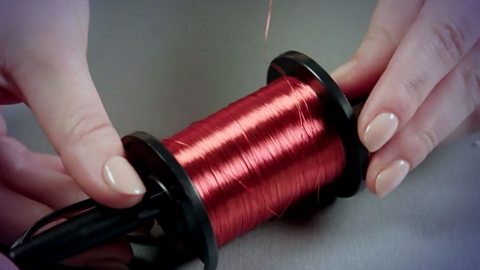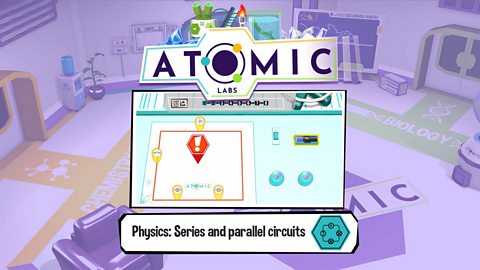Key points
Electrical circuits can be connected in seriesA way of connecting components in a circuit. A series circuit has all the components in one loop connected by wires, so there is only one route for current to flow. or parallelA way of connecting components in a circuit. A parallel circuit has components on separate branches, so the current can take different routes around the circuit..
The current (I)Current is a flow of charges. It is measured in amps (A). is the same in all parts of a series circuit.
resistance (R)How difficult it is for current to flow. increases when components, for example a lamp, are added to a circuit in series.
potential difference (V)The amount of energy transferred by each unit of charge passing between two points of a circuit. The unit for potential difference is the volt (V). is shared between components in a series circuit.
Game - series and parallel circuits
Play an Atomic Labs experiment exploring different arrangements of series and parallel circuits.
You can also play the full game
Video - Series circuits
This string of lights doesn’t seem to be working, but if I tighten just one bulb, they all come on!That’s because these lights are arranged in a series circuit.
Just like a television series has several episodes one after the other, so a series circuit has components arranged one after the other along the same route. There’s only one path for the current to follow.
This simple circuit is like a one-bulb version of my fairy lights. The ammeter shows the current to be nought point nought six amps
Watch what happens when I add another bulb.
Did you see that? When there are two bulbs arranged in series, they both become a little bit dimmer. That’s because the potential difference now has to be shared between two of them, and there’s more resistance in the circuit, reducing the current.
You can see that the ammeter reads nought point nought five amps. And it doesn’t matter where I put the ammeter - that current is the same everywhere.
As well as making the lamps dimmer, series circuits also have the problem that when one bulb doesn’t work, the others go out because there’s now a break in the circuit.
It can be annoying for fairy lights, but it’s a useful safety feature in some electric tools like lawn mowers.
They have two switches that both need to be held closed to complete the series circuit, before the lawnmower will work.
Now, let’s get these up. Oh no not again!
Can you answer these questions based on the video?
What happens when you add a second bulb to a series circuit?
If a bulb breaks in a series circuit, what happens to any other bulb in the circuit?
Both bulbs will be a bit dimmer because the potential difference has to be shared between the two bulbs.
All the bulbs will go out because there is a break in the circuit.
Connecting components in series
When we connect componentA part of a circuit eg a battery, motor, lamp, switch or wire. in series they are all in the same loop one after another, just like episodes of a series on television. The components are connected end-to-end with the last wire completing the circuit to form the single loop, meaning there is only one path for the current (I)Current is a flow of charges. It is measured in amps (A). to flow.
In a series circuit, if a lamp breaks or a component is disconnected, the circuit is broken and all the components stop working.
Current stops flowing in the circuit because there is no longer a complete loop - there is no complete path to allow the current to flow.
switchSwitches can be used to make or break connections in a circuit. Current can only flow if the switch is closed. can be added to a series circuit to turn components on and off.
If any switch is open in a series circuit, then current stops flowing and all the components stop working.
Current and resistance in series circuits
The current (I)Current is a flow of charges. It is measured in amps (A). has the same value everywhere in a seriesA way of connecting components in a circuit. A series circuit has all the components in one loop connected by wires, so there is only one route for current to flow. circuit. It does not matter where you put the ammeterA device used to measure current. Ammeters are connected in series with components., it will give you the same reading.
The circuit here contains a cell, two lamps and three ammeters. The ammeters all give the same reading, because there is only one path to allow the current to flow.
Adding components in series
Adding more components to a series circuit increases the total resistance in the circuit, so less current flows.
The circuit on the left contains a lamp, a cell, a switch, and an ammeter. 4 A of current flows.
The circuit on the right contains two lamps, a cell, a switch, and an ammeter.
The resistance of two lamps is greater than the resistance of one lamp, so the current is lower. The reading on the ammeter is only 2 A. This means the lamps are dimmer.

Current is not used up by the components in a circuit. This means that the current is the same everywhere in a series circuit, even if it has lots of lamps or other components.
Potential difference in series circuits
The potential difference (V)The amount of energy transferred by each unit of charge passing between two points of a circuit. The unit for potential difference is the volt (V). produced by a cell or battery is shared between components in a series circuit. This means if we add up the individual potential differences across each of the components, it equals the potential difference across the cell or battery.
This circuit contains a 6 V battery and two 100 Ω resistorA component which resists the flow of current. in series. voltmeterA device used to measure potential difference. Voltmeters are connected in parallel with components. have been connected across the battery and the components to measure the potential difference.
As the resistors are identical, the potential difference across each resistor is 3 V - it is shared equally between them.
If the components in a series circuit have different resistances, the potential difference does not divide equally across them.
Example
In this diagram the potential difference produced by the battery is 6 V.
The 100 Ω resistor has twice the resistance of the 50 Ω resistor.
The potential difference across the 100 Ω resistor is twice the potential difference across the 50 Ω resistor.
There are 4 V across the 100 Ω resistor and 2 V across the 50 Ω resistor.
4 V + 2 V = 6 V
Try the experiment online
Try out this experiment in Atomic Labs. Go to the Physics lab and try the Series and parallel circuits experiment.
Atomic Labs game. gameAtomic Labs game
Try out practical experiments in this KS3 science game

Resistors in series
If resistorA component which resists the flow of current. are placed in series in a circuit then the overall resistance (R)How difficult it is for current to flow. of the circuit increases.
Example
The diagram shows a 6 Ω resistor in series with a 2 Ω resistor.
The total resistance for these resistors in series is 6 Ω + 2 Ω = 8 Ω.
What is the resistance of this circuit?
The total resistance for these resistors in series is 4 Ω + 5 Ω = 9 Ω.
Test your knowledge
Quiz - Multiple choice
Teaching resources
Looking for more teaching resources to support your lessons on KS3 physics? Head to the BBC Teach website for more free, curriculum-linked resources to help deliver lessons - all arranged by subject and age group.
GCSE exam dates 2025
Find out everything you need to know about the 2025 GCSE exams including dates, timetables and changes to exams to get your revision in shape.

More on Electricity
Find out more by working through a topic
- count10 of 11
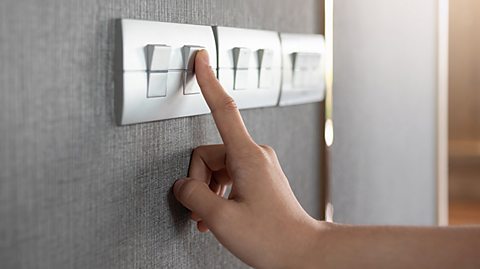
- count11 of 11
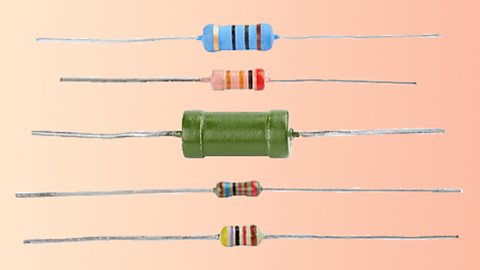
- count1 of 11
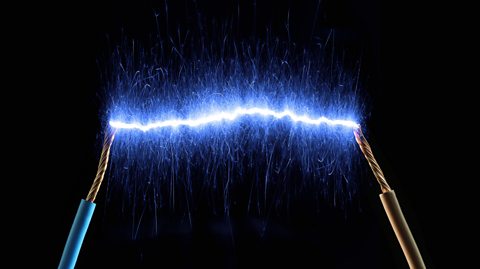
- count2 of 11
